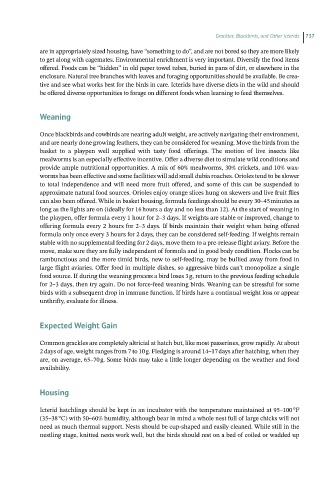Page 735 - Hand rearing birds second
P. 735
Grackles, Blackbirds, and Other Icterids 737
are in appropriately sized housing, have “something to do”, and are not bored so they are more likely
to get along with cagemates. Environmental enrichment is very important. Diversify the food items
offered. Foods can be “hidden” in old paper towel tubes, buried in pans of dirt, or elsewhere in the
enclosure. Natural tree branches with leaves and foraging opportunities should be available. Be crea-
tive and see what works best for the birds in care. Icterids have diverse diets in the wild and should
be offered diverse opportunities to forage on different foods when learning to feed themselves.
Weaning
Once blackbirds and cowbirds are nearing adult weight, are actively navigating their environment,
and are nearly done growing feathers, they can be considered for weaning. Move the birds from the
basket to a playpen well supplied with tasty food offerings. The motion of live insects like
mealworms is an especially effective incentive. Offer a diverse diet to simulate wild conditions and
provide ample nutritional opportunities. A mix of 60% mealworms, 30% crickets, and 10% wax-
worms has been effective and some facilities will add small dubia roaches. Orioles tend to be slower
to total independence and will need more fruit offered, and some of this can be suspended to
approximate natural food sources. Orioles enjoy orange slices hung on skewers and live fruit flies
can also been offered. While in basket housing, formula feedings should be every 30–45 minutes as
long as the lights are on (ideally for 16 hours a day and no less than 12). At the start of weaning in
the playpen, offer formula every 1 hour for 2–3 days. If weights are stable or improved, change to
offering formula every 2 hours for 2–3 days. If birds maintain their weight when being offered
formula only once every 3 hours for 2 days, they can be considered self‐feeding. If weights remain
stable with no supplemental feeding for 2 days, move them to a pre‐release flight aviary. Before the
move, make sure they are fully independent of formula and in good body condition. Flocks can be
rambunctious and the more timid birds, new to self‐feeding, may be bullied away from food in
large flight aviaries. Offer food in multiple dishes, so aggressive birds can’t monopolize a single
food source. If during the weaning process a bird loses 3 g, return to the previous feeding schedule
for 2–3 days, then try again. Do not force‐feed weaning birds. Weaning can be stressful for some
birds with a subsequent drop in immune function. If birds have a continual weight loss or appear
unthrifty, evaluate for illness.
Expected Weight Gain
Common grackles are completely altricial at hatch but, like most passerines, grow rapidly. At about
2 days of age, weight ranges from 7 to 10 g. Fledging is around 14–17 days after hatching, when they
are, on average, 65–70 g. Some birds may take a little longer depending on the weather and food
availability.
Housing
Icterid hatchlings should be kept in an incubator with the temperature maintained at 95–100 °F
(35–38 °C) with 50–60% humidity, although bear in mind a whole nest full of large chicks will not
need as much thermal support. Nests should be cup‐shaped and easily cleaned. While still in the
nestling stage, knitted nests work well, but the birds should rest on a bed of coiled or wadded up

